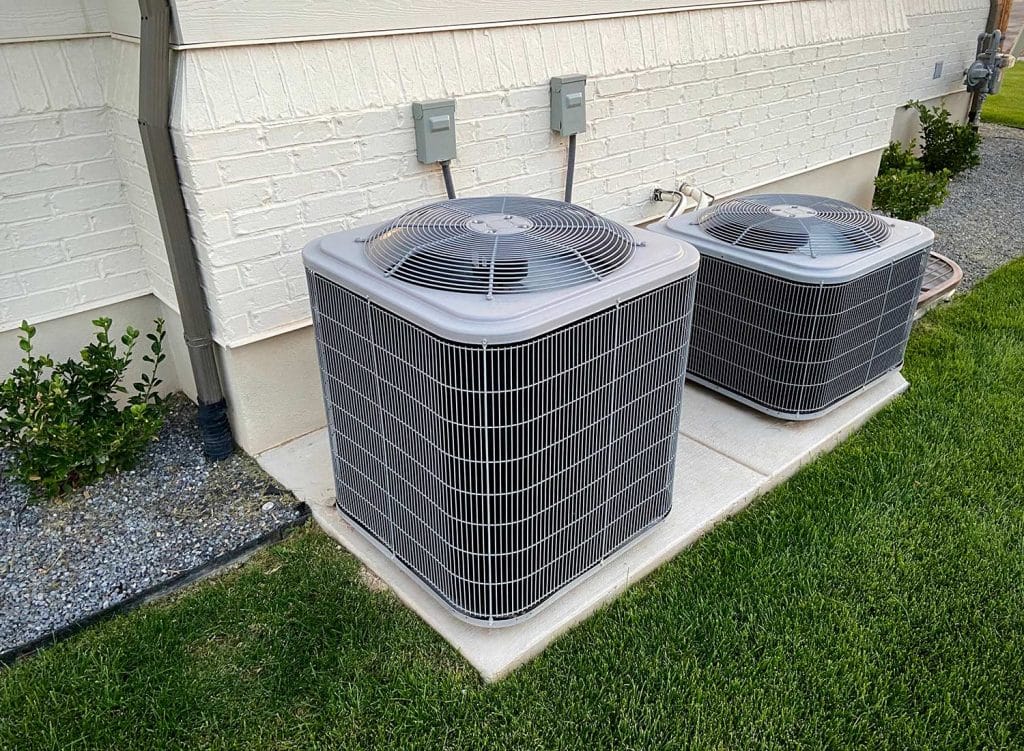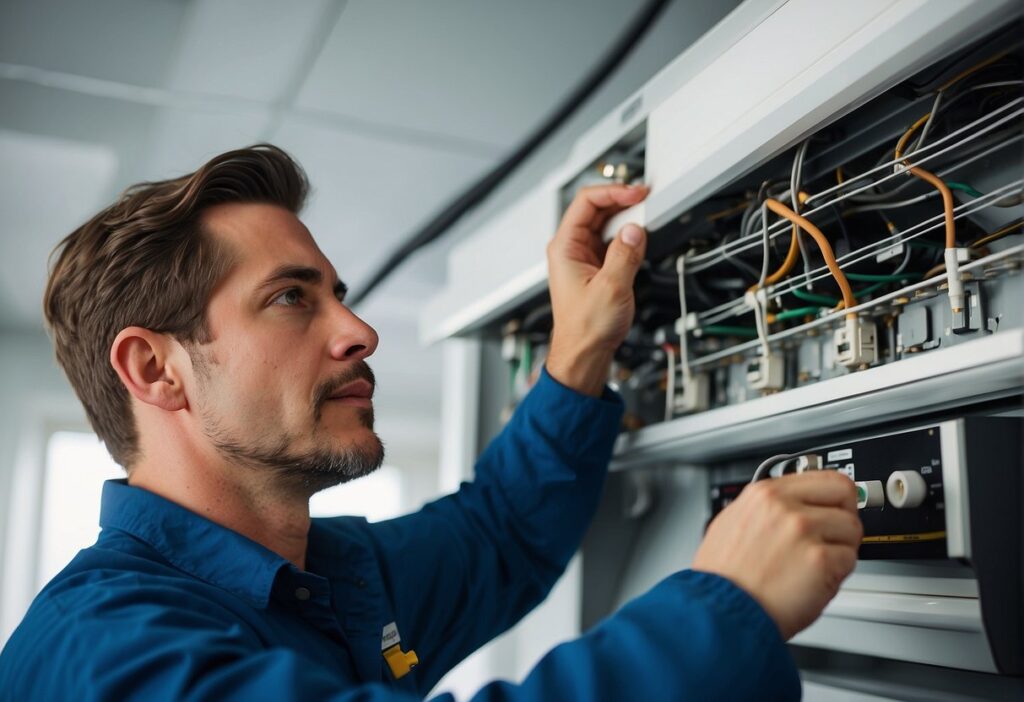
Understanding Split HVAC Systems
Split HVAC systems are a prevalent choice for heating and cooling due to their efficiency and versatility. These systems possess distinct components that work in unison to control the climate within indoor spaces.
Components and Function
Our split system consists of two primary parts: the indoor unit and the outdoor unit. The indoor unit, often mounted on a wall or ceiling, houses the evaporator coil and fan. Cool or warm air is distributed through the space by the indoor unit, typically connected to ductwork or offering ductless operation.
- Outdoor Unit: Contains the compressor and condenser. These work together to dissipate heat during the cooling process.
- Indoor Unit: Includes the air handler, evaporator coil, and filter which cools/warms and filters the air respectively.
- Ductwork/Ventilation: Provides a pathway for the conditioned air to travel throughout the building.
- Thermostat: Enables temperature control, allowing users to set their desired climate.
The process involves refrigerant circulating between the indoor and outdoor units. Through copper pipes, the refrigerant absorbs indoor heat and releases it outdoors, or vice-versa for heating.
Types of Split Systems
Split systems can be categorized based on their setup and functionality.
- Mini-Split Systems: Designed for areas without ductwork, these are ideal for room additions or selective area heating/cooling.
- Multi-Split Systems: These can connect multiple indoor units to a single outdoor unit, which is perfect for individual climate control in separate spaces.
- Traditional Split Systems: These are the most common, involving ductwork for air distribution, with a singular indoor and outdoor unit.
Each type of split system is suited to particular applications, ranging from residential to commercial spaces. They are efficient, adaptable, and can be tailored to meet diverse heating and cooling needs.
Installation and Maintenance Considerations
When we install and maintain split HVAC systems, it’s critical to consider the intricacies of their setup and the ongoing practices that keep them running efficiently. Proper installation ensures optimal function, and diligent maintenance can extend a system’s lifespan.

Installation Process
During the installation phase of a split air conditioner, several key steps must be followed. Firstly, we select an appropriate location for both the indoor and outdoor units, ensuring there’s sufficient space for air circulation and easy accessibility for future maintenance. It’s essential to secure the indoor unit to a wall that can support its weight and to install the outdoor unit on a flat, stable surface or mounting brackets.
Then, we must connect refrigerant lines between the two units, which should be performed by certified HVAC professionals to ensure the system is properly sealed and charged with refrigerant. The electrical wiring must conform to local codes, and a dedicated electrical circuit is often required. Here’s a simplified breakdown of the installation process:
- Select Locations: Indoor and outdoor unit placement.
- Mount Units: Secure indoor unit and properly position outdoor unit.
- Connect Lines: Refrigerant and electrical connections by a professional.
- Finalize Installation: Check for leaks, test unit operation.
Ongoing Maintenance and Care
Regarding ongoing maintenance, regular care is paramount to a split system’s longevity and efficiency. We perform routine checks and cleanings, which minimize labor costs over time by preventing major system failures. The primary tasks include:
- Cleaning Filters: We should clean or replace the air filters in the indoor unit every 1-3 months to prevent airflow blockage and maintain air quality.
- Inspecting Coils and Components: Annually inspect the evaporator and condenser coils for dirt and debris that can inhibit heat transfer.
- Checking Refrigerant Levels: Periodically check refrigerant levels and address leaks promptly to ensure efficient cooling.
- Ensuring Good Airflow: Keep the area around both the indoor and outdoor units clear of obstructions for optimum airflow and system performance.
In summary, proper installation lays the groundwork for a reliable split air conditioning system, and consistent maintenance is key to sustaining the system’s peak performance and efficiency.
Advantages of Split HVAC Systems
When we talk about split HVAC systems, three core benefits come to the forefront: energy savings, application flexibility, and improved climate control. These systems are engineered to provide efficient and reliable temperature management for both residential and commercial spaces.
Energy Efficiency and Savings
Modern split systems boast a high Seasonal Energy Efficiency Ratio (SEER) and Energy Efficiency Ratio (EER), indicating their proficiency in converting electrical energy into cooling or heating while minimizing waste. This translates to lower energy consumption, making them a more energy-efficient option compared to traditional HVAC units. Inverter technology further refines efficiency, as it allows compressors to adjust their performance to the precise requirement of the room, which leads to significant energy savings.
- Energy-Saving Feature: Inverter technology
- Typical SEER Range: High
Design Flexibility and Applications
Our split HVAC systems offer unparalleled flexibility in design and application. They can be readily adapted to a variety of environments, be it residential homes or commercial establishments. The ductless nature of mini-split systems makes them ideal for retrofitting into buildings without existing ductwork, while the modularity of components allows for extensive customization. Notably, these systems can cater to the specific needs of individual rooms, promoting efficient resource use.
- Application: Residential and Commercial
- Customization: High
Comfort and Climate Control
Split systems excel in creating a comfortable indoor climate by providing precise temperature control. The zoning capability allows us to control the temperature in individual rooms, thereby avoiding the unnecessary heating or cooling of unoccupied spaces. Lower noise levels of internal units contribute to a more serene environment. Additionally, the inclusion of heat pumps in some models means we can enjoy both heating and cooling from the same unit, further enhancing comfort. The ability to adjust settings via a remote control adds a layer of convenience to the overall user experience.
- Temperature Control: Precise
- Noise Levels: Low
Cost and Economic Factors
When considering Split HVAC systems, two paramount factors to assess are the initial financial outlay and the ongoing expenses linked to operation. These elements are decisive in determining the system’s cost-effectiveness over its lifecycle.
Initial Investment
The upfront cost for Split HVAC systems generally varies depending on the unit’s size, features, and efficiency. Systems with higher Seasonal Energy Efficiency Ratio (SEER) ratings and those labeled as ENERGY STAR by the Department of Energy often come with a higher purchase price. For example, a Split HVAC system with a SEER rating of 21 will typically be more costly compared to a unit with a SEER rating of 14. However, these efficient systems are designed to reduce long-term electricity consumption.
- Typical price range for basic models: $1,500 – $2,500
- High-efficiency models: $3,000-$7,500+
- Additional installation costs: $500 – $2,500
Operational Costs
Once installed, the operational costs of a Split HVAC system are contingent upon their energy efficiency, cooling capacity, and the type of refrigerants they use. Systems featuring a high SEER rating are more energy-efficient, which can lead to significant energy savings on electricity bills. While standard models may have a SEER rating around 14, we recommend opting for systems with a SEER rating of at least 16 for optimal energy savings.
Packaged units that combine heat pump systems with a gas furnace can offer both heating and cooling more efficiently than traditional systems. They utilize a heat exchanger to transfer heat rather than generating it through fuel consumption, leading to additional savings.
- Average annual electricity cost for standard system: $300 – $1,000
- Reduced cost for high-efficiency system: up to 40% savings on electricity bills
- Potential repair and maintenance costs: $150 – $700 per year
Potential Drawbacks and Considerations
When considering a split HVAC system for your heating and air conditioning needs, it’s important to acknowledge not just the benefits, but also the potential drawbacks and factors that may affect its viability for your specific situation.
Limitations and Challenges
Space Utilization and Aesthetics: We find that ductless systems, such as mini-split systems, may have an impact on the aesthetics of a space. The indoor units of these systems are visible and require wall or ceiling space that could otherwise be utilized for decor or other purposes in both home additions and commercial settings.
- Home Applications: For home environments, an indoor unit in each room can be intrusive.
- Commercial Applications: In business settings, seamless design may be more crucial, and visible units can detrude from the professional appearance.
Functionality in Extreme Weather: Even though split system air conditioners are highly efficient, the outdoor compressor units may face challenges in extreme weather conditions, which can impact their functionality.
- Hot Climates: Compressor units can overheat if not properly shaded or ventilated.
- Cold Climates: For some systems, efficiency drops in freezing temperatures, necessitating supplemental heating solutions.
Professional Evaluation for Suitability
Home and Building Assessments: Before opting for a split HVAC system, our recommendation is to have a professional evaluate if your home or commercial building is suitable for such an installation. Packaged systems or central split systems might be more appropriate in certain cases, depending on the layout and existing infrastructure.
- Ductless Mini Split Compatibility: Not every space is well-suited for a ductless mini split, especially if multiple areas need consistent heating and cooling.
- Centralized Systems Consideration: For large-scale or interconnected spaces, a traditional centralized system might offer better airflow and temperature consistency.
Maintenance and Filtration: Split systems require regular maintenance, including cleaning or replacing air filters. Accumulation of debris in the outdoor compressor unit or on air filters can affect Seasonal Energy Efficiency Ratio (SEER) ratings and system longevity.
- Filters: Managing filters is critical to maintaining air quality and system efficiency.
- Debris: Regular checking and cleaning of the outdoor unit are necessary to avoid blockages that could compromise the system.
Frequently Asked Questions
In this section, we’ll cover some of the most common inquiries regarding split HVAC systems, ensuring you have a clear understanding of their benefits and uses.
What are the advantages of using a ductless mini split system over traditional HVAC?
Ductless mini split systems offer flexibility in zoning, which allows for individual temperature control in different rooms. They are also easier to install as they do not require ductwork. This reduces energy loss associated with ducted systems and can lead to lower utility costs.
How do split HVAC systems fare in terms of energy efficiency?
Split HVAC systems generally exhibit higher energy efficiency compared to traditional systems. They use inverter-driven compressors that adjust their speed to maintain consistent indoor temperatures, which significantly reduces energy consumption.
What are the common applications for split system air conditioners in residential settings?
Split system air conditioners are commonly used in residential settings, such as single-family homes, apartments, or condos, especially where adding ductwork is impractical. They’re ideal for supplementing existing heating and cooling systems or for providing climate control in new additions or renovated spaces.
How does a mini split system function differently from a standard air conditioner?
A mini split system functions by having individual air-handling units for each room or zone, connected to a single outdoor compressor. Unlike standard air conditioners that cool air through a central unit and distribute it via ducts, mini splits deliver air directly into each zone, reducing energy loss and increasing efficiency.
What should be considered when choosing between a mini split and a central air system?
When choosing between a mini split and a central air system, consider factors like the layout of your home, the presence of existing ductwork, energy efficiency preferences, and specific heating and cooling needs. Mini splits may offer a more targeted and economical solution if ductwork is not present or if individual room control is desired.
Can ductless split systems be a viable primary heating solution in cold climates?
Ductless split systems can serve as a primary heating solution in cold climates, particularly models designed with a hyper-heating feature that operates efficiently at very low temperatures. These systems are capable of extracting heat from the outside air even when it’s cold and can be an effective and efficient primary heat source.

